Schedule a Call Back
Digital PCR: Taking research to the next frontier
 Technical Articles
Technical Articles- Jan 01,18

Related Stories

Digital PCR: Taking research to the next frontier
Andrew J Birnie explains in detail considerations to be given for extraction, stabilisation and quantification by PCR for sensitive sample such as RNA. The accessibility of PCR (polymerase chain rea..
Read moreRelated Products

Kusam-meco” 1000v Dc Hand Held Digital Insulation Resistance Tester - Model- Km 372
Kusam-Meco has added a new hand-held digital insulation resistance tester cum digital multimeter for the convenience of electricians.

Kusam-meco” 1000v Dc Hand Held Digital Insulation Resistance Tester
Kusam Electrical Industries Ltd offers Kusam-Meco” 1000V DC hand held digital insulation resistance tester - Model- KM 372.

Tensile Strength Tester
Globe Enterprises offers a wide range of tensile strength tester.















